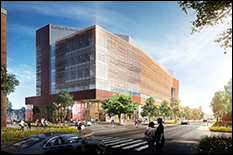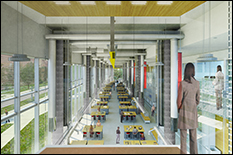News Story
A New Era in Human Health Innovation
The construction of A. James Clark Hall is made possible, in part, by the generosity of two benefactors, A. James Clark and Dr. Robert E. Fischell. Clark's gift of $15 million supports the design and construction of the new engineering building, while Fischell's gift of $6 million will help the Fischell Department of Bioengineering establish a new home and launch the Robert E. Fischell Institute for Biomedical Devices.
 The new A. James Clark Hall at the University of Maryland, College Park, will spur the development of transformative new engineering and biomedical technologies that advance human health innovation. When it opens in 2017, the 184,000-square-foot building will serve as a central hub for new partnerships and collaborations for organizations throughout the Maryland and Washington, D.C. region. The new building will facilitate world-class research and educational programs, offering state-of-the-art laboratories, student project space, and a new home for the Fischell Department of Bioengineering and the Robert E. Fischell Institute for Biomedical Devices, further expanding the capabilities and impact of the A. James Clark School of Engineering.
The new A. James Clark Hall at the University of Maryland, College Park, will spur the development of transformative new engineering and biomedical technologies that advance human health innovation. When it opens in 2017, the 184,000-square-foot building will serve as a central hub for new partnerships and collaborations for organizations throughout the Maryland and Washington, D.C. region. The new building will facilitate world-class research and educational programs, offering state-of-the-art laboratories, student project space, and a new home for the Fischell Department of Bioengineering and the Robert E. Fischell Institute for Biomedical Devices, further expanding the capabilities and impact of the A. James Clark School of Engineering.
Clark Hall, which will be located adjacent to the Jeong H. Kim Engineering Building, will accommodate the Clark School’s rapidly growing programs, reducing class space deficiency by 20 percent, while bringing together the many disciplines involved with human health innovation under one roof, encouraging interdisciplinary collaboration and growth, from electrical and mechanical engineering to biology and information technology. Some 7,332 square feet of classroom space and 11,402 square feet of class lab space will support instructional capabilities.
To help spur an organic flow of ideas between many disciplines, the new building will introduce flex classrooms and two stories of flexible laboratories to the campus, including wet and dry spaces as well as a vivarium, and will be designed to engage the public with an atrium that greets everyone who enters the building. That means anyone from within the campus or greater community will be welcome to convene at Clark Hall and participate in a culture of innovation.
Optical laser and imaging laboratories will feature state-of-the-art technology in digital fabrication, rapid prototyping, 3-D printing, optics, and bioinformatics. In the imaging suite, students and faculty will have the ability to examine molecular resolution of pathogens, whether in the GI tract or bloodstream, that show how a nano-carrier delivers a drug to a specific tumor site. Laser devices and magnetic resonance imagers will allow a close examination of cross-sections of the body and brain.
Within an hour’s-drive from College Park are many of the nation’s top bioscience research forces, including the National Institutes of Health (NIH), Walter Reed National Military Medical Center, the U.S. Army Medical Research and Materiel Command at Fort Detrick, the University of Maryland, Baltimore School of Medicine, the Johns Hopkins University School of Medicine, the U.S. Food and Drug Administration (FDA), and the National Institute of Standards and Technology (NIST).
 Clark Hall capitalizes on that geographic advantage, allowing networking and collaboration opportunities not only for all University of Maryland faculty, staff, and students but also for professionals from around the region.
Clark Hall capitalizes on that geographic advantage, allowing networking and collaboration opportunities not only for all University of Maryland faculty, staff, and students but also for professionals from around the region.
“With our presence here in the D.C.-Baltimore corridor, we may have the largest biomedical research capacity in the world, and when you take advantage of this special location, you can do great things,” said William Bentley, Robert E. Fischell Distinguished Professor and Founding Chair of the Fischell Department of Bioengineering. “Clark Hall is being built basically from the bottom up to be a hub of activity—to bring people from elsewhere in the Clark School of Engineering, the University of Maryland, the University of Maryland, Baltimore, from companies nearby, from the FDA to NIH, all with the idea of inspiring new technologies to improve human health.”
Producing engineering innovations, and innovators, is where the Clark School's potential for greatness lies. Through creativity and hard work we've already achieved successes well beyond the level our resources would predict, and begun to receive the recognition of our peers. We call on those who value our work—alumni, students, faculty, partners and friends—to come forward, contribute their knowledge, energy and financial resources, and help us produce innovations and innovators that will change the world. Get involved here.
Published March 15, 2015









